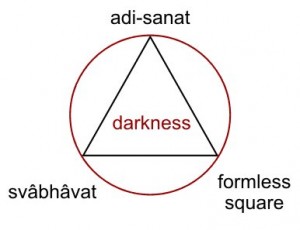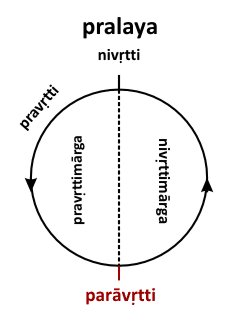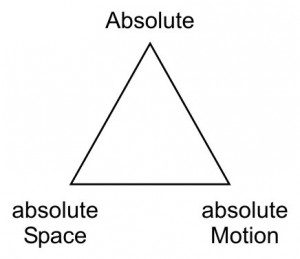The third fundamental proposition of the secret doctrine (SD
I, 17) postulates “the fundamental identity of all Souls
with the Universal Over-Soul, the latter being an aspect
of the Unknown Root”. We might ask ourselves, what exactly
is this Over-Soul, and how can we relate it to other known
concepts in the philosopy of The Secret
Doctrine?
1. The Over-Soul
The term Over-Soul refers to Ralph Waldo Emerson’s essay
The Over-soul, first published in 1841, in which he
describes the Over-soul as the source of higher inspiration in
man. From the essay:
The Supreme Critic on the errors of the past
and the present, and the only prophet of that which must be, is
that great nature in which we rest as the earth lies in the soft
arms of the atmosphere; that Unity, that Over-soul, within which
every man’s particular being is contained and made one with all
other; that common heart of which all sincere conversation is the
worship, to which all right action is submission; that
overpowering reality which confutes our tricks and talents, and
constrains every one to pass for what he is, and to speak from
his character and not from his tongue, and which evermore tends
to pass into our thought and hand and become wisdom and virtue
and power and beauty. We live in succession, in division, in
parts, in particles. Meantime within man is the soul of the
whole; the wise silence; the universal beauty, to which every
part and particle is equally related; the eternal
ONE.
In the third fundamental proposition, it is stated that the
Universal Over-Soul is “an aspect of the Unknown
Root”. The Unknown Root is what we have identified with the
Absolute, or space, symbolised by the plane or circumference of
the circle, i.e. the circle without a central point, the
immaculate white disk from the archaic palmleaf manuscript
described in SD I, 1. An aspect of the Root will be one of three
aspects. On the same page the Universal Over-Soul is described as
the “pure Essence of the Universal Sixth
principle”, while the seventh principle is the Root
itself. The principles are counted here from “dense”
to “fine”. On page 19 this sixth principle is
identified with brahmā. On page 13 (footnote), a
fifth universal principle is mentioned, under the name of
ākāśa, “to which
corresponds and from which proceeds human Manas”.
2. The Universal Soul
The statements on the Universal Soul in The Secret
Doctrine are very confusing, to say the least. In the third
fundamental proposition we find that the Over-Soul is the sixth
universal principle. In another location in the Proem, SD I, 9-10
we find:
The Occultist […] regards the Adi-Sakti
[…], in her A’kasic form of the Universal Soul — as
philosophically a Maya, and cause of human Maya. But this view
does not prevent him from believing in its existence so long as
it lasts, to wit, for one Mahamanvantara; nor from applying
Akasa, the radiation of Mulaprakriti,* to practical purposes,
connected as the World-Soul is with all natural phenomena, known
or unknown to science.
From this we can distill that the Universal Soul is not the
First unmanifested Logos, but the Second. In SD I, 420 we find a
more unequivocal statement on the Universal Soul:
UNIVERSAL SOUL is not the inert Cause of
Creation or (Para) Brahma, but simply that which we call the
sixth principle of intellectual Kosmos, on the manifested plane
of being. It is Mahat, or Mahabuddhi, the great Soul, the vehicle
of Spirit, the first primeval reflection of the formless CAUSE
[…].
It is clear from this quotation that the Universal Soul is
identical to the Second Logos, the sixth universal principle,
Mahat, the “Universal Mind”. This means that the
Universal Soul is none other than the “Universal
Over-Soul” of Emerson.
3. The Anima Mundi or World Soul
In SD I, 365 and the first footnote on that page, we find
evidence that this principle, which we call here the Second Logos
(here referred to as Brahma), is also identical with Anima Mundi
or the World Soul:
In the Hindu Katakopanishad, Purusha, the
divine spirit, already stands before the original matter, “from
whose union springs the great soul of the world,” Maha-Atma,
Brahma, the Spirit of Life,* etc., etc.**[…]
* The latter appellations are all identical
with Anima Mundi, or the “Universal Soul,” the astral light of
the Kabalist and the Occultist, or the “Egg of
Darkness.”
Then in SD I, 49 (and other locations), we find the statement
that ālaya is the Universal Soul and Anima
Mundi:
In the Yogacharya system of the contemplative
Mahayana school, Alaya is both the Universal Soul (Anima Mundi)
and the Self of a progressed adept.
Whenever HPB uses ālaya, she refers to the Second Logos
(unless otherwise indicated), although on the same page (SD I,
49) she states that the word ālaya has “two or even
three meanings”. In our discussion on Ālaya in the
Laṅkāvatārasūtra Pt. II, we have argued
what the two or three meanings might be, namely the jāti,
pravṛtti and karman aspects of ālaya.
4. Corrections to Earlier Findings
So, we have to correct two errors in our earlier posts. Part
of the table in Ālaya in the
Laṅkāvatārasūtra Pt. II
was:
| Aspect of ālaya | 1. jāti | 2. pravṛtti |
| Corresponds to | remaining in its original nature | evolving |
| Cosmic | Universal Soul |
Mahat [called Maha-Buddhi], Universal Mind, [Universal Spiritual Soul], Emerson’s Over-Soul, Anima Mundi |
with the remark: “It may be noted that these conclusions
do not in every respect meet the ones from The Three
Logoi. The differences concern the terms Universal Soul and
Anima Mundi. It will be necessary to clear up these differences
in a later stage.” We know now, that this part of the table
should have looked like:
| Aspect of ālaya | 1. jāti | 2. pravṛtti |
| Corresponds to | remaining in its original nature | evolving |
| Cosmic |
|
Mahat [called Maha-Buddhi], Universal Mind, Universal Soul, Emerson’s Over-Soul, Anima Mundi |
In the post entitled The Three Logoi (3), the Universal
Soul is categorized under the Third Logos, while it should have
been under the Second. The corrected text would
be:
- First Logos, the One, the Ever Unmanifest, represented by
Mūlaprakṛti, the Plotinic
and Orphic Hen, Hyparxis, Universal Good, the Christian
Father-aspect, Divine Will. - Second Logos, the manifested Logos, the Logos proper, the
Verbum, the Plotinic Nous, the Demiurge, HPB’s Anima Mundi,
Creative Intelligence, Mahat, Universal Mind, Universal Soul,
Universal Intelligence, Divine Mind, Divine Wisdom, the
Son-aspect, the Christ, Brahmā, Īśvara,
Avalokiteśvara (manifested). - Third Logos, the Light of the Logos, Fohat,
Daiviprakṛti, the Plotinic Psuchē,Universal Soul, the Nous of Anaxagoras, Divine
(the Plotinic Anima Mundi)
Activity, the Holy Ghost.
5. The Sacred Four
In stanza IV, śloka 5 (SD I, 98) the four highest
universal principles are described. Here, the seventh (first)
principle is called darkness, the sixth (second) adi-sanat, the
fifth (third) svâbhâvat, the fourth (fourth) the
formless square. The first three are “enclosed within the
boundless circle”, and together they are called the
sacred four or the tetraktis.

In the following table, the four highest Universal
(“Cosmic”) principles are summarized, as described in
various sources.
| Principle | 7th | 6th | 5th | 4th |
| Proem to the SD |
the ONE principle, the Absolute, THAT, Sat, Be-ness, SPACE, the Root, Parabrahman, Brahman (neutrum) |
Universal Over-Soul, Universal Soul, Brahmā |
ākāśa | |
| SD I, 98 (st. IV śl. 5) | darkness | adi-sanat | svâbhâvat | formless square |
| SD II, 596 | The Unmanfested Logos | Universal (latent) Ideation | Universal (or Cosmic) active Intelligence | Cosmic (Chaotic) Energy |
|
Cosmological Notes in BL p. 378; spelling cf. Blavatsky’s Secret Books, p. 64 |
svayambhuva | nārāyaṇa | yajña | vāc |
| snyugs | dkon mchog | nam ‘mkha (Skt. ākāśa) | ‘od (Skt. prabhā, āloka) | |
| Latent Spirit Ensoph | Universal Mind | Virāj, Universal Illusion | Cosmic Will | |
| Additional terms |
Mother-space, the Eternal Parent, Eternal Mother (1886 Ms), First Logos |
Second Logos | Father-Mother, Fire-Mist |
Category: Alaya, Anima Mundi, Brahma, Cosmogenesis, Darkness, Logos, Mahat, Rootless Root, Space, Svabhavat, Universal Mind, World Soul | No comments yet


